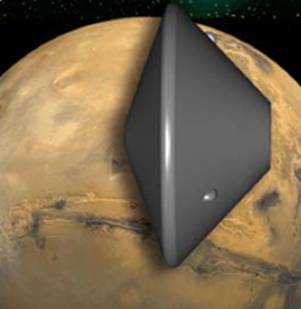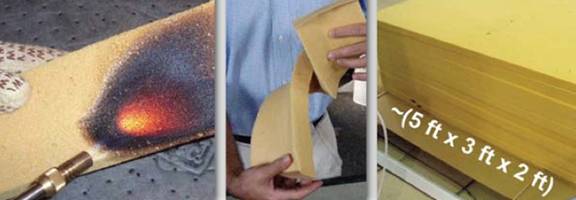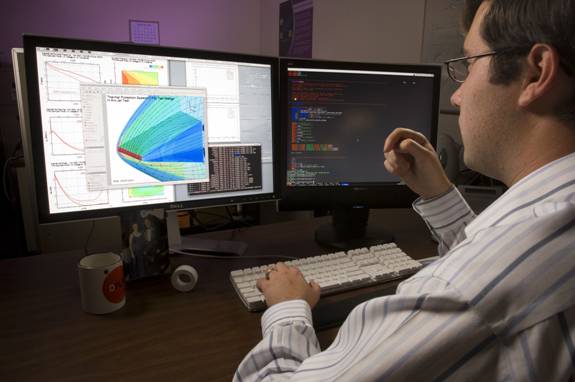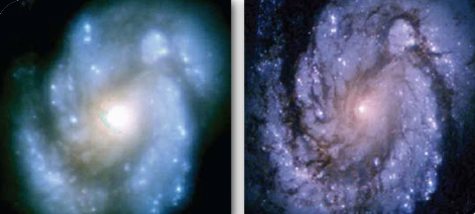



Invention of the Year Awards for 2007
The Government Invention of the Year for 2007 is the PICA and SIRCA Low-Density Resin Impregnated Ceramics. It is a well-known fact that one of the toughest ongoing problems NASA has to deal with is the heat of entering a planet's atmosphere at sub-orbital speed. This patented suite of ceramic ablator technologies called PICA and SIRCA Low-Density Resin Impregnated Ceramics developed at NASA’s Ames Research Center has been used on four missions to date, all with good success.
The innovation lies in the ability to tailor the density of thermal protection systems by forming woven fiber matrices. Resin is then deposited to the desired thickness on the fibers by controlling the evaporation of excess resin or carrier solvent from the article. This results in the appropriate resin coating thickness for each application. A later patent focuses on layered combinations of materials made using the above method.
The technology has been licensed and the nearly infinite combinations of fibers and resins that could be developed using this method should enable broad commercial, government and military applications.
FPF-44 Polyimide Foams, developed at NASA’s Langley Research Center, is the Commercial Invention of the Year for 2007. FPF-44 meets a growing need for high-performance flexible polymeric foams for cryogenic, thermal and acoustic insulation, fireproofing, energy absorption, and other applications. LaRC's Flexible Polyimide Foam is made from four ingredients and was invented by four people, hence the name FPF-44. This polyimide foam technology exceeds the performance of commercial foams that are currently used on the Space Shuttle External Tank, is more durable, lighter, and has a higher use temperature. FPF-44 is applicable to a wide range of industrial uses including flame retardants, fire protection, thermal insulation, acoustic insulation, gaskets, seals, vibration damping pads- virtually anywhere foam is currently used. The exceptional flame retardant nature of FPF-44 products can improve the safety of watercraft, aircraft, and spacecraft, electronics and electrical products, automobiles, recreation equipment, and buildings. Increased use includes hundreds of thousands of board feet purchased by the US Navy and Coast Guard for flame retardant ship insulation. The licensee/co-inventing company has had to increase production capability to meet the increased demand.
Software of the Year Awards for 2007
The Data-Parallel Line Relaxation (DPLR) Code, developed at NASA’s Ames Research Center, is used to analyze and predict the extreme environments human and robotic spacecraft experience during extreme high-speed entries into planetary atmospheres. These high fidelity simulated entry environments are necessary for engineers to design and apply thermal protection materials suited to withstand them since they cannot be duplicated in full scale in any test facility on Earth. DPLR has significantly impacted science and technology beyond its direct support of NASA primary mission objectives. It has been transferred to multiple government, industry, and university partners for use within the Department of Defense, the Department of Energy, civilian aerospace, and fundamental research endeavors. Several DPLR-derived tools are in active development within universities and industry across the country.
DPLR already has a major impact on NASA and defense aerospace industries, and can potentially benefit civilian aerospace as well. Other uses of DPLR include breakup of de-orbiting debris (as demonstrated recently in a collaborative effort between NASA Ames Research Center and Kennedy Space Center), and missile plume signature analysis. Potential applications include all civilian and military entry vehicles, hypersonic and supersonic cruise vehicles, and commercial and military launch systems. The performance and physical modeling innovations in the DPLR software have the potential to greatly enhance the design and optimization of such systems. Also, the generalized chemical kinetics and transport property packages in DPLR make it potentially valuable for the simulation of combustion flows for both aerospace and non-aerospace applications (such as reactors or combustion engines).
The Adaptive Modified Gerchberg-Saxton (MGS) Phase Retrieval program, developed at NASA’s Jet Propulsion Laboratory, uses a telescope's science camera with innovative and robust algorithms to characterize possible errors that limit its imaging performance. The software has been integrated into calibration control loops to correct those errors, and can achieve orders of magnitude improvement in sensitivity and resolution. It is in use at the California Institute of Technology's Palomar Observatory and played a significant role in designing NASA's James Webb Space Telescope, scheduled to launch in 2013. Early work for the JPL software was based on NASA's Hubble Space Telescope correction techniques. MGS can be applied to other sciences and systems that use light, such as laser communications and extra-solar planet detection.
Runner up awards were given to:
High charge Z and E TraNsport 2005 (HZETRN) from Langley Research Center
Interoperable Remote Component (IRC) Architecture from Goddard Space Flight Center
Multidimensional, Multiphysics Computational Heat Transfer Analysis Software from Johnson Space Center
 ICB Home
ICB Home Back
Back

